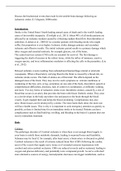Discuss the biochemical events that result In irreversible brain damage following an
ischaemic stroke (3-5 diagram, 2000words)
Introduction
Stroke is the United States' fourth leading annual cause of death and is the world's leading
cause of irreversible incapacity. (Towfighi et al., 2011) About 90% of all stroke patients are
affected by an ischemic incident caused by a blocking sudden blood flow from thrombus or
embolism. (Lakhan et al., 2009) If we consider patients with bleeding stroke who might
suffer, this proportion is even higher. Ischemic stroke damages primary and secondary
ischemic and offensive insults. The initial ischemic period results in a primary damage which
takes oxygen and essential nutrients, for example glucose, out of the brain,
The central nervous system (CNS) cells are essential for survival. The first damage is
triggering the death of neurons in the infarct tissue, while the influx of immunes, reactive
oxygen species, and toxic inflammatory mediators is affecting the cells in the penumbra. (Liu
et al., 2012)
Delayed ischemic events resulting from subarachnoid haemorrhage arterial or arteriolar
vasospasms. When a blood artery carrying blood to the brain is crossed by a blood clot, an
ischemic stroke occurs. The bulk of strokes are of this kind. The effects depend on the
damaged areas of the brain. They may involve such symptoms as: extreme numbness or
weakening of the face, arm, or leg, sometimes on one side of the body, discomfort, speech or
comprehension difficulties, dizziness, lack of control or coordination, or difficulty walking,
and more. Two key forms of ischaemic stroke exist: thrombotic strokes; caused by a clot of
blood that occurs in an artery that provides the brain with blood. Embolic stroke; They arise
as a clot develops in the body anywhere else and passes to the brain through the blood
vessels. It gets trapped there and keeps the blood circulating. Complications may also
arise. Brain tissues can be destroyed by a stroke. The more harm that's done, the more one
will have health issues. This is why it is important to seek emergency attention as quickly as
possible, as there is limited time for an immediate stroke to be treated. Patients can have
complications such as fluid build-up, swelling, and bleeding in the brain if a patient does not
receive immediate treatment.
Body
Cellular
The pathologic disorder of Cerebral ischemia is when there is not enough blood supply to
your brain to satisfy these metabolic demands, leading to neuronal losses and feasibility.
Schemas may be focal if, for example, after heart arrest, a brain artery is obscured or global.
Cerebral ischemia is the result of extreme reduced brain flow (CBF) following the cardiac
arrest of the vessels that supply nerve tissue or of extended systemic hypotension with
cerebral and extra-cerebral occlusion. CBFs are reduced severely and/or sustained, leading to
oxygen and glucose deficiency and potentially toxic compound growth. As nerve cells don't
store alternative sources of energy, hemodynamic decreases can trigger metabolism, such as
, ATP, resulting in decreased metabolism, failure of the energy, ionic disturbances and
ischemical damage. (Siesjo et al., 1989) Cells experiencing serious ischemia will die or show
a delayed vulnerability within minutes of the insult. Ischemic attacks can both be localized or
global, permanent or temporary which can cause post-ischemia areas to be repercussed.
Metabolic and ionic homeostasis can reverse and cell survival can be preserved depending on
how early reperfusion is triggered. Classically, the neuron has proven very susceptible to
cerebral ischemia cycles. Flow reductions in rodents of up to 25ml/100g/min are thought to
be severe enough to potentially lead to cell death. (Bolander et al., 1989) The period of
ischemia also defines frailty trends in addition to the magnitude of the ischemic insult (Heiss
and Rosner, 1983). A short duration of serious ischemia may lead, for example, to specific
neuronal damage, with minimal cellular changes in glia and blood vessels (Brierley et al.,
1982). However, other cellular responses can be observed with longer ischemic times which
eventually lead to ischemic infraction (Jacobson et al., 1982). Damage to the brain blood
vessels and inflammatory processes can lead to hemorrhagic tissue transformation and
serious brain swelling with reperfusion injury (del Zoppo and Mabuchi, 2003).
Fig 1., Cerebral Oedema (Swope, 2013)
Biochemical responses
During full ischemia, there are three major forms of biochemical changes in the tissue:
anoxia, substrate deficiency and accumulation of metabolic waste products. Because the
tissue's oxygen reserves are only adequate for a few seconds of uninterrupted oxidative
metabolism, the development of aerobic energy rapidly ceases. As this happens, the tissue
can only acquire energy by using its ATP and phosphocreatine (PCr) stores, and by
anaerobically metabolising glucose and glycogen to lactic acid. The estimated equation gives
the total amount of energy (~ -P) that can be made available.
Ischemia and the resulting hypoxia contribute to the derangement of energy-intensive
processes that are important for brain homeostasis. In sodium, calcium and potassium ion
homeostasis, defective ATP dependent ion pumps result in consequent imbalance, resulting
in the release of excitatory amino acids such as glutamate (Olne et al., 1986). By stimulating




